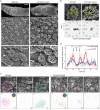Tracheal motile cilia in mice require CAMSAP3 for the formation of central microtubule pair and coordinated beating
- PMID: 34319756
- PMCID: PMC8684751
- DOI: 10.1091/mbc.E21-06-0303
Tracheal motile cilia in mice require CAMSAP3 for the formation of central microtubule pair and coordinated beating
Abstract
Motile cilia of multiciliated epithelial cells undergo synchronized beating to produce fluid flow along the luminal surface of various organs. Each motile cilium consists of an axoneme and a basal body (BB), which are linked by a "transition zone" (TZ). The axoneme exhibits a characteristic 9+2 microtubule arrangement important for ciliary motion, but how this microtubule system is generated is not yet fully understood. Here we show that calmodulin-regulated spectrin-associated protein 3 (CAMSAP3), a protein that can stabilize the minus-end of a microtubule, concentrates at multiple sites of the cilium-BB complex, including the upper region of the TZ or the axonemal basal plate (BP) where the central pair of microtubules (CP) initiates. CAMSAP3 dysfunction resulted in loss of the CP and partial distortion of the BP, as well as the failure of multicilia to undergo synchronized beating. These findings suggest that CAMSAP3 plays pivotal roles in the formation or stabilization of the CP by localizing at the basal region of the axoneme and thereby supports the coordinated motion of multicilia in airway epithelial cells.
Figures





Similar articles
-
CAMSAP3 facilitates basal body polarity and the formation of the central pair of microtubules in motile cilia.Proc Natl Acad Sci U S A. 2020 Jun 16;117(24):13571-13579. doi: 10.1073/pnas.1907335117. Epub 2020 Jun 1. Proc Natl Acad Sci U S A. 2020. PMID: 32482850 Free PMC article.
-
Electron cryotomography of intact motile cilia defines the basal body to axoneme transition.J Cell Biol. 2020 Jan 6;219(1):e201907060. doi: 10.1083/jcb.201907060. J Cell Biol. 2020. PMID: 31874113 Free PMC article.
-
Wdr47, Camsaps, and Katanin cooperate to generate ciliary central microtubules.Nat Commun. 2021 Oct 4;12(1):5796. doi: 10.1038/s41467-021-26058-5. Nat Commun. 2021. PMID: 34608154 Free PMC article.
-
The multifaceted roles of microtubule-associated proteins in the primary cilium and ciliopathies.J Cell Sci. 2023 Dec 1;136(23):jcs261148. doi: 10.1242/jcs.261148. Epub 2023 Dec 14. J Cell Sci. 2023. PMID: 38095645 Review.
-
Cilia and centrosomes: Ultrastructural and mechanical perspectives.Semin Cell Dev Biol. 2021 Feb;110:61-69. doi: 10.1016/j.semcdb.2020.03.007. Epub 2020 Apr 16. Semin Cell Dev Biol. 2021. PMID: 32307225 Review.
Cited by
-
Structure, function and druggability of the African trypanosome flagellum.J Cell Physiol. 2022 Jun;237(6):2654-2667. doi: 10.1002/jcp.30778. Epub 2022 May 26. J Cell Physiol. 2022. PMID: 35616248 Free PMC article. Review.
-
LRRC6 regulates biogenesis of motile cilia by aiding FOXJ1 translocation into the nucleus.Cell Commun Signal. 2023 Jun 16;21(1):142. doi: 10.1186/s12964-023-01135-y. Cell Commun Signal. 2023. PMID: 37328841 Free PMC article.
-
Coordination of Cilia Movements in Multi-Ciliated Cells.J Dev Biol. 2022 Nov 11;10(4):47. doi: 10.3390/jdb10040047. J Dev Biol. 2022. PMID: 36412641 Free PMC article. Review.
-
A polarized multicomponent foundation upholds ciliary central microtubules.J Mol Cell Biol. 2025 Jan 30;16(8):mjae031. doi: 10.1093/jmcb/mjae031. J Mol Cell Biol. 2025. PMID: 39165107 Free PMC article.
-
Vestibular Hair Cells Require CAMSAP3, a Microtubule Minus-End Regulator, for Formation of Normal Kinocilia.Front Cell Neurosci. 2022 Jun 17;16:876805. doi: 10.3389/fncel.2022.876805. eCollection 2022. Front Cell Neurosci. 2022. PMID: 35783105 Free PMC article.
References
-
- Baines AJ, Bignone PA, King MD, Maggs AM, Bennett PM, Pinder JC, Phillips GW (2009). The CKK domain (DUF1781) binds microtubules and defines the CAMSAP/ssp4 family of animal proteins. Mol Biol Evol 26, 2005–2014. - PubMed
-
- Bautista-Harris G, Julia-Serda G, Rodriguez de Castro F, Santana-Benitez I, Cabrera-Navarro P (2000). Absence of central microtubules and transposition in the ciliary apparatus of three siblings. Respiration 67, 449–452. - PubMed
-
- Berryman M, Franck Z, Bretscher A (1993). Ezrin is concentrated in the apical microvilli of a wide variety of epithelial cells whereas moesin is found primarily in endothelial cells. J Cell Sci 105 (Pt 4), 1025–1043. - PubMed
-
- Burgoyne T, Lewis A, Dewar A, Luther P, Hogg C, Shoemark A, Dixon M (2014). Characterizing the ultrastructure of primary ciliary dyskinesia transposition defect using electron tomography. Cytoskeleton (Hoboken) 71, 294–301. - PubMed
Publication types
MeSH terms
Substances
LinkOut - more resources
Full Text Sources
Miscellaneous

